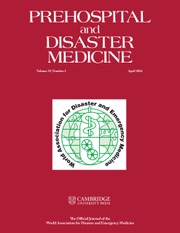No CrossRef data available.
Article contents
Ready, Set, Deploy: AUSMAT’s Surgical Cache Gets a Makeover
Published online by Cambridge University Press: 21 May 2025
Abstract
The Australian Medical Assistance Team (AUSMAT), a Type 2 Emergency Medical Team launched a project to ensure its surgical cache remains perpetually deployment ready for response to sudden-onset disasters and other health emergencies.
The objectives of this project included: inventory accuracy, compliance with standards, expiry date management, procurement and replenishment, functionality and condition, quality assurance, education and training, workforce review and budget compliance.
Two AUSMAT perioperative specialist nurses for a period of 8 months were appointed to critically audit the surgical cache through all phases of the perioperative environment with a major focus on the World Health Organization (WHO) Classification and Minimum Standards for Emergency Medical Teams and Australian Sterilizing Standards - AS5369:2023. The specialist nurses engaged with key stakeholders such as the AUSMAT Surgical Working Group and the AUSMAT Preparedness and Response Team. Furthermore, an online AUSMAT nursing workforce survey and review were completed.
The project involved detailed planning, development, and implementation, resulting in strategic recommendations for continuous quality improvement processes. Key outcomes included operational efficiency and an enhanced surgical educational program. Financial gains were realized through scrutiny of surgical equipment and rationalizing purchases while maintaining WHO EMT Type 2 verification status.
The project outcome includes strategic recommendations for continuous quality improvement processes and highlights the potential for further developing the AUSMAT Surgical Course. This initiative ensures operational efficiency and strengthens AUSMAT capacity to respond effectively to health emergencies.
Information
- Type
- Meeting Abstracts
- Information
- Copyright
- © The Author(s), 2025. Published by Cambridge University Press on behalf of World Association for Disaster and Emergency Medicine


